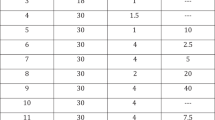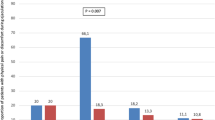Abstract
Radical retropubic prostatectomy (RRP) is an important cause of iatrogenic erectile dysfunction (ED). While sildenafil has been widely used since its introduction as a new treatment option for ED, its efficacy in post-RRP patients has not been extensively studied. We retrospectively compared the efficacy of sildenafil in post-RRP and non-surgical patients with ED (NSED) using a subset of questions from the International Index of Erectile Function (IIEF) and correlated results with their specific etiology of ED based on penile blood flow study (PBFS).
A brief questionnaire regarding satisfaction with sildenafil was administered to 72 consecutive post-RRP patients (nerve sparing status unknown) and 32 consecutive NSED patients who had previously undergone PBFS with pharmacotesting as part of their evaluation for ED. PBFS diagnoses were arterial insufficiency (AI) for peak systolic velocity (PSV)<25 cm/sec; venogenic (CVOD) for PSV≥35 cm/sec, mixed vascular for PV>25 but<35 cm/sec and resistive index (RI)<0.9; a vascular normal diagnosis (neurogenic impotence) required excellent rigidity sustained for 20 min. Differences in the IIEF subscores for the different groups of patients were assessed. Success with sildenafil was defined as moderate or excellent improvement (3/4 or 4/4) with ability for penetration.
No differences were found among the different subgroups of RRP patients with respect to IIEF scores or success rates with sildenafil. NSED patients had both significantly higher post-treatment IIEF scores (3.6/3.4 vs 2.5/2.2; t=4.50, P<0.0001) and success rates (63% vs 31%; t=3.11, P<0.01) with sildenafil treatment than RRP patients.
We found that sildenafil is significantly less effective in impotent RRP patients than in age-matched patients with ED (31% vs 63%). We had postulated that sildenafil would be least effective among RRP patients with excellent sustained rigidity to PGE1, as this subgroup is likely to have neurogenic impotence. We found that sildenafil response rates among subgroups of RRP patients were statistically similar regardless of PBFS diagnosis. IIEF scores for the RRP subgroups were similar but statistically lower than in men with ED and no history of RRP. While individuals with normal vascular responses to PGE1 have an increased likelihood of having neurogenic impotence, in RRP patients, we were unable to demonstrate any difference in efficacy of sildenafil, regardless of the PBFS diagnosis.
This is a preview of subscription content, access via your institution
Access options
Subscribe to this journal
Receive 8 print issues and online access
$259.00 per year
only $32.38 per issue
Buy this article
- Purchase on Springer Link
- Instant access to full article PDF
Prices may be subject to local taxes which are calculated during checkout
Similar content being viewed by others
Author information
Authors and Affiliations
Corresponding author
Rights and permissions
About this article
Cite this article
Blander, D., Sanchez–Ortiz, R., Wein, A. et al. Efficacy of sildenafil in erectile dysfunction after radical prostatectomy. Int J Impot Res 12, 165–168 (2000). https://doi.org/10.1038/sj.ijir.3900525
Received:
Revised:
Accepted:
Published:
Issue Date:
DOI: https://doi.org/10.1038/sj.ijir.3900525
Keywords
This article is cited by
-
Effect of sildenafil administration on penile hypoxia induced by cavernous neurotomy in the rat
International Journal of Impotence Research (2008)
-
Vardenafil: A new approach to the treatment of erectile dysfunction
Current Urology Reports (2003)
-
The International Index of Erectile Function (IIEF): a state-of-the-science review
International Journal of Impotence Research (2002)



